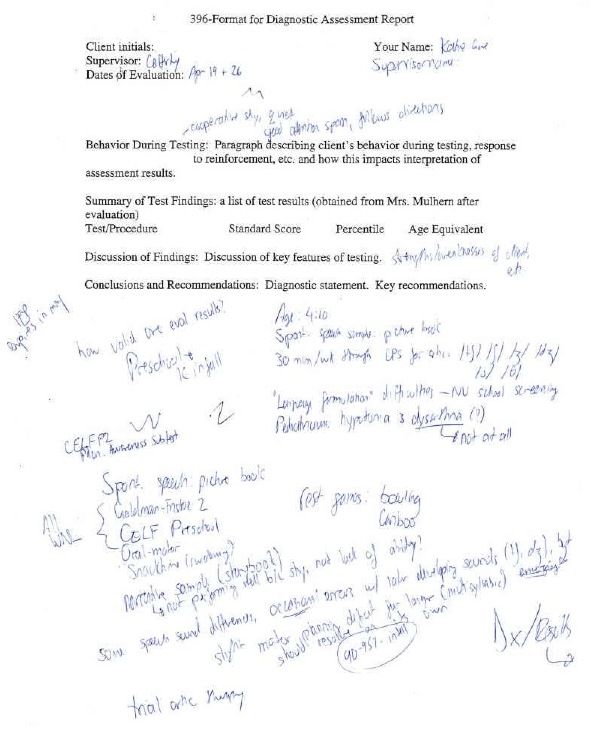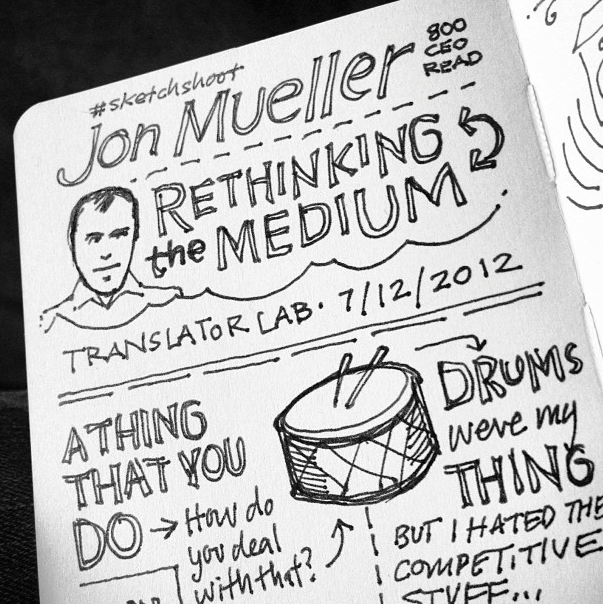Speech-language pathology attracts a very particular personality type. Over 95% of SLPs are female, for starters. SLPs tend to be both highly organized and creative, and this is especially true if you glance at how most SLP students take notes. My classes were full of beautifully-colored notebooks with bubbly, blocky handwriting neatly sectioned by headers, bullet points, and arrows.
My notes, on the other hand, looked like this:

My actual notes from grad school. Ah, diagnostics.
While taking notes during a session recently, a client asked me, "Did you ever want to be a doctor?"
Finding the right flow
While some habits have evolved since grad school, my haphazard stream-of-consciousness note-taking style has remained unchanged. I typically end up with multiple pages of diagonal zig-zagging chicken scratch after a session. (This is why I always send clients nicely-organized typed notes after every meeting.)
Since I've been out of the lecture note routine for a few years now, I've been pondering how best to take notes during the many research and discussion sessions at ASHA this year. Last year at ISHA I determined to rely solely on my iPad, but found it clunky for switching between handouts and various note-taking apps (Pages, Noterize, etc.). In grad school I used my laptop for lectures, but I've found as a practitioner that I really just want to collect key statements and standout figures from continuing ed lectures.
And, even though I'm committed to being digital and paperless, at the end of the day I'm happiest and capture more meaningful notes when I'm with my pen, 8.5x11 paper, and clipboard. So how do I avoid ending up with 100 pages of splayed-out writing that I often can't decode myself?
Sketchnotes

My friend Greg frequently speaks at conferences and recently introduced me to "sketchnotes". Sketchnotes is a way of taking notes that is highly graphical, visual, and big-impact. Wired author James Kelly describes the key premise as "listen more intently, link imagery to the verbal concept and create a more concrete memory, filter out distractions."
Google "sketchnotes" and you will find some pretty incredible and intimidating-looking works of textual art. I am not a designer or artist, but the foundational philosophy of sketchnotes appeals to my preferred jumbled flow. After reading Kelly's review, I purchased sketchnote artist Mike Rohde's book so that I can be ready to apply this at ASHA.
The toolbox
I've made plenty of attempts in the past to force my workflow into something that "seems" good, only to find it didn't fit me personally (such as note-taking on the iPad). Many sketchnote samples I've seen are completed in Moleskines or other small, bound books.
I love my clipboard and but I hate saving piles of paper-based notes. Even though I record my thoughts on paper, all my session data and notes get scanned to my computer using my ScanSnap, and the paper form is destroyed. My brain needs paper real estate to keep thoughts spread out before I connect them. The thought of a small notebook gives me mental claustrophobia.
So, here is the toolkit I've landed upon for ASHA 2013:
- The Sketchnote Handbook (ebook, viewable on my iPad): for previewing and reviewing between sessions
- Clipboard
- Stacks of loose-leaf 8.5x11 printer paper: to be scanned and PDF'd post-ASHA
- 3-4 fine-point black Sharpie pens: I don't like switching back and forth for colors during lectures
Check back for more!
I'll be tweeting and posting my newbie sketchnotes over the next few days to see how they evolve. If you're also interested in trying this out at ASHA, connect with me (@speechIRL or e-mail) and share your notes! Looking forward to what the ASHA 2013 sketchnotes gallery has to show!
